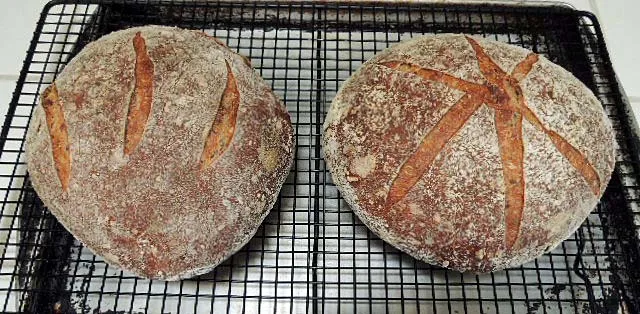
Sourdough Honey Whole Wheat with Multi-grain Soaker
May 17, 2013
This is my third version of a whole wheat, multi-grain bread based on my San Francisco-style Sourdough formula. I think this one is a keeper.
Compared to the last version:
The soaker was hydrated at 100% rather than 125%. Also, it was soaked for less than an hour rather than overnight. This resulted in a very sticky, slack dough but not a goopy one. It behaved like a 75-80% hydration dough, generally.
The soaker was mixed into the dough right after the autolyse, rather than being added after the gluten was well-developed. I had some concern that this might compromise the crumb structure, but I am quite happy with what I got. (See photos, below.)
I reduced the percentage of honey slightly.
I did not retard the dough in bulk but, rather, as formed loaves.
I did not leave the loaves in the turned off oven but removed them to the cooling rack immediately after they were fully baked. This step is still a good option, if you want a drier, harder crust.
Total dough | Bakers' % | Wt (g) |
AP flour | 34 | 192 |
Bread flour | 14 | 79 |
Medium Rye flour | 2 | 14 |
WW Flour | 50 | 281 |
Water | 93 | 528 |
KAF “Harvest Grains” | 18 | 100 |
Honey | 3 | 17 |
Salt | 1.9 | 11 |
Total | 225.9 | 1222 |
Stiff levain | Bakers' % | Wt (g) |
Bread flour | 95 | 79 |
Medium rye flour | 5 | 11 |
Water | 50 | 45 |
Stiff starter | 80 | 66 |
Total | 230 | 201 |
Dissolve the starter in the water. Add the flours and mix thoroughly until the flour has been completely incorporated and moistened.
Ferment at room temperature for 16 hours.
Soaker | Bakers' % | Wt (g) |
KAF “Harvest Grains” | 100 | 100 |
Water (Boiling | 100 | 100 |
Total | 200 | 200 |
Just before mixing the autolyse, put the “Harvest Grains” blend in a medium-sized bowl and pour the boiling water over it. Cover.
Allow to soak during the autolyse (see below).
Final dough | Wt (g) |
AP flour | 169 |
WW Flour | 274 |
Water | 350 |
Salt | 11 |
Honey | 17 |
Soaker | 200 |
Stiff levain | 201 |
Total | 1222 |
Method
In a stand mixer, mix the flours and water at low speed until they form a shaggy mass.
Cover and autolyse for 30 minutes
Add the salt, honey, soaker and levain and mix at low speed for 2-3 minutes, then increase the speed to medium (Speed 2 in a KitchenAid) and mix for 6 minutes. Add flour and water as needed. The dough should be rather slack.
Place the dough in a lightly oiled bowl and cover tightly.
Ferment at 70º F for 2 1/2 to 3 hours with a stretch and folds in the bowl every 30 minutes for the fist 2 hours.
Divide the dough into two equal pieces.
Pre-shape as rounds and rest, covered, for 10 minutes.
Shape as boules or bâtards and place in bannetons. Place bannetons in plastic bags.
Proof at room temperature (68-70º F) for 1-2 hours.
Cold retard the loaves overnight.
The next morning, proof the loaves for 2-3 hours.
45-60 minutes before baking, pre-heat the oven to 480º F with a baking stone and steaming apparatus in place.
Transfer the loaves to a peel. Score the loaves as desired, turn down the oven to 460º F, steam the oven, and transfer the loaves to the baking stone.
After 15 minutes, remove the steaming apparatus, and turn down the oven to 435º F/Convection. (If you don't have a convection oven, leave the temperature at 460º F.)
Bake for another 15 minutes.
Transfer the loaves to a cooling rack, and cool thoroughly before slicing.
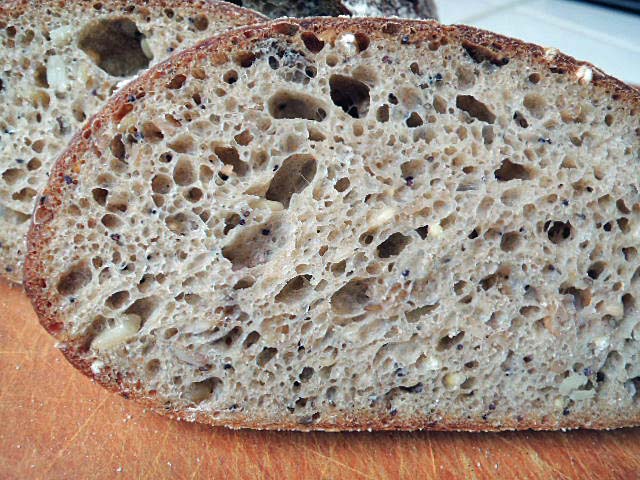
The crust was chewy. The crumb was not at all gummy but was very moist when the bread was first sliced the morning after baking. The flavor was that of good whole wheat. There was little noticeable sweetness. There was a moderately prominent sourdough tang. The bread was tasted plain and toasted with almond butter and jam. It was quite delicious. Probably because I was tasting it about 16 hours after it was baked, the flavor was more balanced than that of the last version which I first tasted just 2 to 3 hours after it was baked.
I will be tasting this bread over the next few days. I expect it to stay moist for at least 3 or 4 days.
Yesterday, along with these breads, I also baked a San Joaquin Sourdough bâtard.
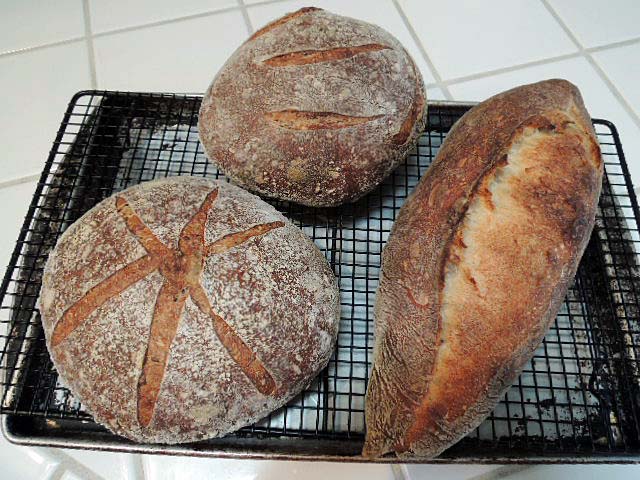
And I used 400g of the SJSD dough to make a focaccia with garlic, fresh rosemary and zucchini.
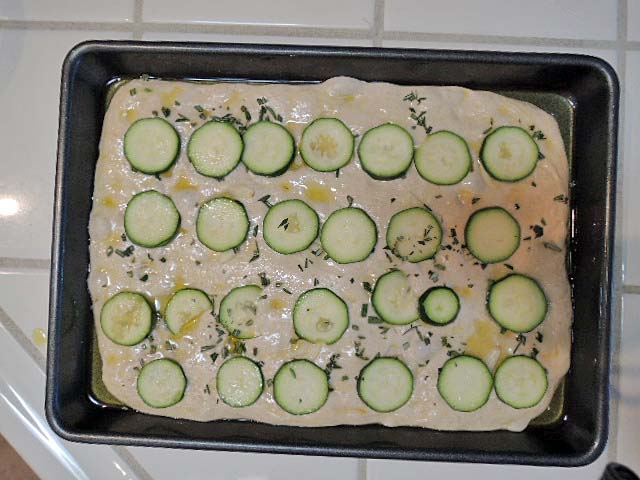
Focaccia, readty to bake
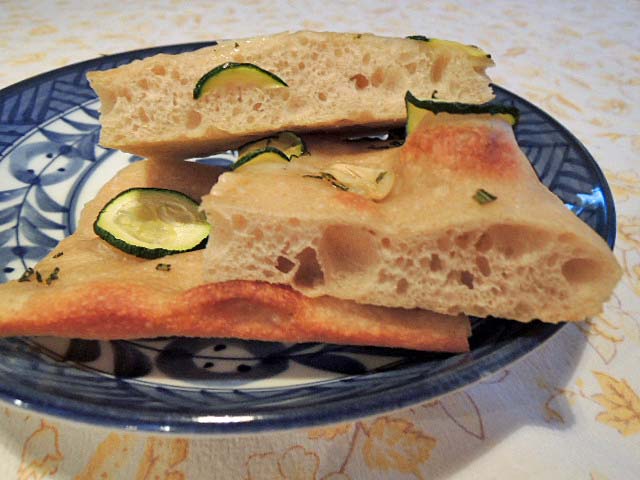
David
Submitted to YeastSpotting
- dmsnyder's Blog
- Log in or register to post comments
Lovely, David. May I feature this for a bit?
Of course, I'd be honored to have you feature it.
David
This also reminds me that I took an advanced baking class this week (will post about it soon) and we made a loaf nearly identical to the one I'd made at home the day before but it included a soaker of cracked grains at about the same percentage as you have here. I tend to be skeptical about "adding stuff" to my bread, but it really was quite excellent. It made my previous loaf taste... flat. So there is yet another dimension for me to explore and learn about.
I admire the adventurousness of those who try unconventional ingredients, but most don't appeal to me. The exceptions are grain/seed mixes, which are both nutritionally beneficial and tasty, and nuts and dried fruits, which I also enjoy occasionally.
If you want to experience a variety of reliable formulas with various soakers, Hamelman's various multi-grain and seeded breads are delicious.
David
Thanks for the tip.
What a wonderful crumb for 50% wheat. How is the sourness of the loaf? I imagine this one will improve with a little age as well. With such a short soak do the grains have more bite this time around?
Josh
I would say this version is a bit more tangy than the others. I have made other sourdough whole wheat breads in which the sourdough tang and the whole wheat flavors seemed to clash. Somehow, they complement each other in this bread.
The only component of the grain mix that had noticeably more "bite" was the flax seeds. Note that there are no whole wheat or rye berries; they are flaked. There are oat groats and millet. They get rather lost as part of the "background." This is not a bad thing. The melded flavors are delicious.
David
kind of bread we try to make because it tastes so good and is so healthy....just can't seem to get that open crumb though. The taste has to be wonderful with the whole WW and soaker. We try to make them as sour as we can :-) Just love everything about this bread. The SJ looks spot on and has to taste pretty good too,
Happy Baking David
David-
Looks and sounds great. How do you make the starter? Ingredients and grams?
I assume you are not asking how one develops a starter from scratch. So, assuming you already have a healthy, active starter, here is how I manage mine:
I keep my "mother starter" in the refrigerator. It is fed at a ratio of 1:2:4 (Starter:Water:Flour). When feeding the mother, I mix 50 g starter, 100 g water and 200 g flour to make 350 g total. This is refrigerated imediately after mixing. I refresh the mother every 2 to 3 weeks. The flour feeding is a mix of 70% AP, 20% WW and 10% Medium or whole rye.
When preparing to make bread, I generally refresh the starter as a liquid starter at a ratio of 20:50:50 (Mother starter:Water:Flour) using the same flour mix described above. This is fermented to peak activity at room temperature (generally about 12 hours).
This refreshed liquid starter is then fed again according to the specific formula I am following. In other words, the degree of hydration, the flour mix, the ratio of levain:water:starter and the fermentation time and temperature are variable. When posting a formula, I specify these variables.
David
Does this mean that at 1:2:3 or 1:2:4 the "mother starter" can go longer between feeds? Can I use part of the "stiff" mother starter to make a 100% hydration starter for my bakes @ e.g. 1:2:2? Would it still be considered a 100% hydration starter if the original mother starter was not fed with equal water and flour in the first place? Pls excuse me if I seem to be bombarding you with a series of questions.
I've learnt a lot from TFL and I'm happy to say that most of the things I've learnt come from you. Thank you very much David
Judy
Well, if you eat more at a meal, you don't get hungry again as soon. If you give yeast more flour, you don't have to feed them as often. (Note that, whatever ratio of starter to water to flour you use, your starter will be happiest if the feedings are consistant.)
Regarding converting a firm to a liquid starter: Well, of course, if you take a 100% hydration starter and use it to make a 50% hydration starter, and you want to be very precise, you need to adjust the amounts of water and flour just a bit. Of course, after a second feeding as a firm starter, the hydration will be very close to 50%.
If precision is very important to you, please read this:
Converting starter hydrations: A Tutorial. Or through thick and thin and vice versa
David
I was curious about the bite as the soaker I use which is a hot cereal 9 grain blend (which contains wheat, rye, corn, flax, etc..) is unpleasantly crunchy if not soaked for at least 4 hours(even better overnight). You mention some Whole Wheat Sours you have made clashing in flavor. In those recipes is the levain wheat based? I know when I make my levain with wheat it is much more "ripe" after 12 hours than a white based levains. Maybe the Whole Wheat Sour using a white levain is what brings the perfect balance to the flavors. So whats next? Turn the SFSD into a Rye mutation? A Rye Sourdough with a grain soaker (and still a fabulous open crumb).
Happy Baking David
Josh
Very interesting questions about the starter. In fact, the breads I recall where I disliked the flavor were 100% WW and used a levain that was fed with 100% WW.
I don't know "what's next." But I'll probably post it here. ;-)
David
What a beautiful, grain studded crumb, David! Wow, this looks like an excellent multigrain wholewheat bread.
Which Whole wheat flour did you use?
Beautiful!
-Khalid
I have been using a finely-ground whole wheat flour from Giusto's. I get it in bulk from Whole Foods Market. I am really impressed with the difference in crumb structure a finely milled whole wheat flour makes.
David
i know this is a keeper, i already bookmarked this post!! thanks David for sharing and inspiring...
perfect crumb as always!! you must be a very observant and patience man. i've got a lot to learn :)
evon
David
David, could there be a miscalculation in your baker's percentages for the total dough? You list total % as 194.9, but it is clearly 34+14+2+50+93+18+3+1.9 = 215.9. It might be that I'm missing something here, but I don't think so...
You are correct. Thanks for catching that. Serves me right for relying on an automatic table calculation.
David
David, thank you for coming up with such an enticing bread. I've got the levain ready and fermenting away -- will mix the dough tomorrow!